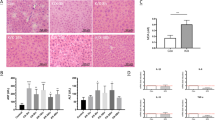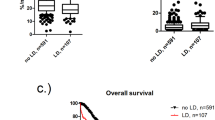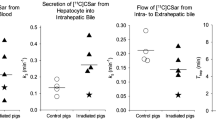Abstract
The caffeine test measures the activity of cytochrome P450 (CYP1A2) which is a major enzyme involved in the activation of flutamide. The usefulness of this test in predicting flutamide-induced hepatic injury in patients with prostate cancer was examined. The subjects were: (1) five patients whose aspartate aminotransferase (AST) or alanine aminotransferase (ALT) level rose to 100 IU/l or higher following the start of flutamide (moderately injured group); (2) four patients whose AST and ALT levels were higher than normal but less than 100 IU/l (mildly injured group); and (3) two patients whose hepatic function remained normal (normal group). The subjects were each given canned coffee to drink. Urinary caffeine (137X), paraxanthine (17X) and 1, 7-dimethyluric acid (17U) levels were measured 4–5 h later. The metabolite ratio, (17U+17X)/137X, was calculated to serve as an indicator of CYP1A2 activity. The metabolite ratio for the moderately injured group (3.98±1.56) and the mildly injured group (5.55±1.42) were lower than that for the normal group (9.56). The results suggest that a decrease in CYP1A2 activity is involved in the onset of flutamide-induced hepatic injury, and that the caffeine test seems to provide a useful means of its prediction.
This is a preview of subscription content, access via your institution
Access options
Subscribe to this journal
Receive 4 print issues and online access
$259.00 per year
only $64.75 per issue
Buy this article
- Purchase on Springer Link
- Instant access to full article PDF
Prices may be subject to local taxes which are calculated during checkout




Similar content being viewed by others
References
Aso Y et al. Clinical evaluation of flutamide, a pure antiandrogen, in prostatic cancer phase II dose-finding study Acta Urol Jpn 1993 39: 391–403
Satoh T et al. A case of fulminant hepatitis caused by antiandrogen, flutamide in a patient with prostate cancer Nippon Hinyokika Gakkaishi 1997 88: 694–696
Sakurai M et al. A case of flutamide-induced acute cholestatic hepatitis Rinsho Hinyokika 1998 52: 851–853
Okaneya T, Murata Y, Kinebuchi Y . Fatal hepatic failure following hepatitis caused by flutamide: a case report Nippon Hinyokika Gakkaishi 1999 90: 590–593
Fau D et al. Toxicity of the antiandrogen flutamide in isolated rat hepatocytes J Pharmacol Exp Ther 1994 269: 954–962
Berson A et al. Metabolic activation of the nitroaromatic antiandrogen flutamide by rat and human cytochromes P-450, including forms belonging to the 3A and 1A subfamilies J Pharmacol Exp Ther 1993 265: 366–372
Watanabe N et al. In vitro effects of fluoroquinolone anti-bacterial agents on flutamide metabolism in human liver microsomes Jpn J Clin Pharmacol Ther 2001 32: 65–71
Brockmöller J, Roots I . Assessment of liver metabolic function. Clinical implications Clin Pharmacokinet 1994 27: 216–248
Daniel SS, Bertino JS Jr, Nafziger AN . Phenotyping of drug-metabolizing enzymes in adults: a review of in vivo cytochrome P450 phenotyping probes Pharmacogenetics 2000 10: 187–216
Nakajima M et al. Phenotyping of CYP1A2 in Japanese population by analysis of caffeine urinary metabolites: absence of mutation prescribing the phenotype in the CYP1A2 gene Cancer Epidemiol Biomarkers Prevention 1994 3: 413–421
Butler MA et al. Determination of CYP1A2 and NAT2 phenotypes in human populations by analysis of caffeine urinary metabolites Pharmacogenetics 1992 2: 116–127
Carrillo JA, Benítez J . Caffeine metabolism in a healthy Spanish population: N-acetylator phenotype and oxidation pathways Clin Pharmacol Ther 1994 55: 293–304
Kagebayashi Y et al. Total androgen blockade for prostate cancer Acta Urol Jpn 1997 43: 197–201
Ozono S et al. A prospective randomized multicenter study of chlormadinone acetate versus flutamide in total androgen blockade for prostate cancer Jpn J Clin Oncol 2000 30: 389–396
Yamaguchi A et al. Study of flutamide-induced liver disorders Nishinihon J Urol 2001 63: 469–471
Nakagawa Y, Koyama M, Matsumoto M . Flutamide-induced hepatic disorder and serum concentrations of flutamide and its metabolites in patients with prostate cancer Acta Urol Jpn 1999 45: 821–826
Wada T et al. Risk factor of liver disorders caused by flutamide—statistical analysis using multivariate logistic regression analysis Acta Urol Jpn 1999 45: 521–526
Author information
Authors and Affiliations
Corresponding author
Rights and permissions
About this article
Cite this article
Ozono, S., Yamaguchi, A., Mochizuki, H. et al. Caffeine test in predicting flutamide-induced hepatic injury in patients with prostate cancer. Prostate Cancer Prostatic Dis 5, 128–131 (2002). https://doi.org/10.1038/sj.pcan.4500564
Received:
Revised:
Accepted:
Published:
Issue Date:
DOI: https://doi.org/10.1038/sj.pcan.4500564



